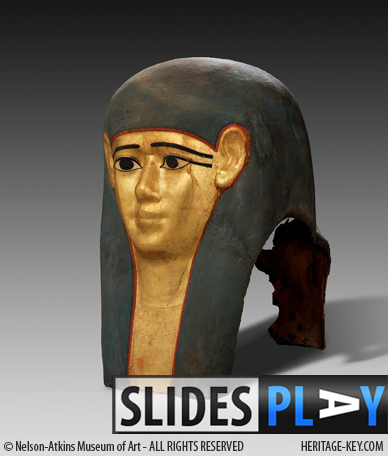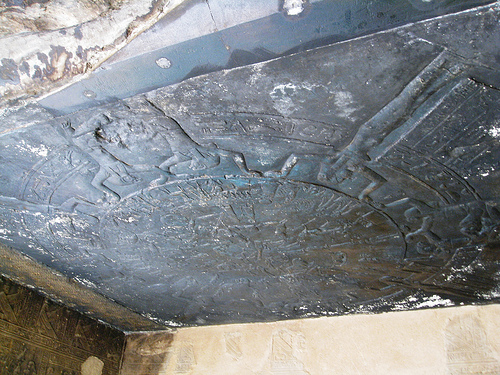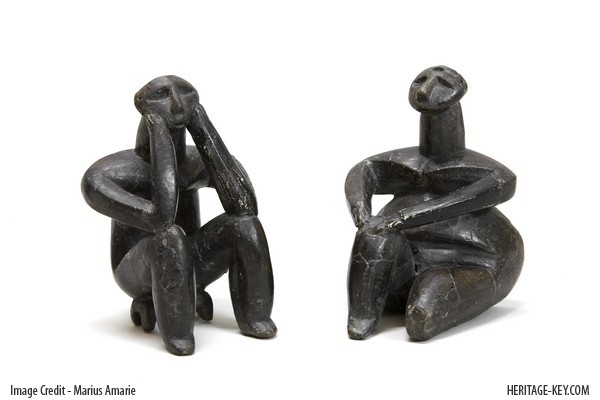The Nelson-Atkins Museum of Art in Kansas City has just opened a new Egyptian gallery that features the coffin, cartonnage and shabtis of an Egyptian noblewoman who died around 2,300 years ago. Her name was Meretites which means beloved by her father. Her funerary artefacts date to some point between 380-250 BC. This date means that she may well have been contemporaneous with Alexander the Great and witness to a remarkable period of Egyptian history. Alexander the Great advanced into Egypt in 332 BC, taking over power from the Persians. He would go on to conquer an empire that stretched…
-
-
An ancient ‘stone goat’ covered in strange rock paintings has been discovered in central China. The ‘incredible’ relic was found by a team of student archaeologists led by Ma Baoguang in Yangce Town, Biyang County, Henan Province. The goat, which is 8m long and 3.7m wide, is covered in around 500 of the paintings, which consist of rounded craters joined by lines to create what experts believe may be an ancient map of the region, famous for the village of Banpo and Yangshao culture. Several larger craters have also been spotted. “It is quite incredible that a large stone goat…
-
One of the most famous, popular and mysterious ancient Egyptian treasures of the Louvre, the 2060-year-old Le zodiaque de Dendéra – the Dendera Zodiac – has witnessed more than its fair share of controversy over the centuries. Stripped from the portico of a chapel dedicated to Osiris at the Hathor Temple at Dendera in 1820, then shipped to Paris, the beautifully carved bas-relief played an unlikely role in fierce disputes over science and faith in Napoleonic and Restoration France. Today, the zodiac continues to spark debate. As the first known depiction in history of the classical zodiac of twelve signs,…
-
Liberal Democrat leader Nick Clegg vows to return the Elgin Marbles to Greece if voted into power in today’s general election. As an MEP (Member of the European Parliament) in 2002 Clegg even spearheaded a conference on sending the marbles back to Athens named Marbles in Exile. Clegg described the marbles being housed in the British Museum (BM) like displaying Big Ben in the Louvre. When Tory MEPRoger Helmer criticised the stance, Clegg wrote to him, “During the opening of the Marbles in Exile exhibition yesterday, I took the opportunity to read out your message. Everyone agreed that you appear…
-
in New York holds one of the largest and most famous collections of Egyptian material in the world. Today, it opens a brand-new, long-term exhibition gathering together 170 pieces from within its Egyptian collection titled The Mummy Chamber. Its an exploration of the many complex ancient Egyptian afterlife rituals and beliefs, which were all intended to protect a deceased soul from harm once they passed-on, and ensure a pleasant experience on the other side. It covers everything from mummification to the placing of votive goods in burial chambers. Organised by the Brooklyn Museums Curator of Egyptian Art Edward Bleiberg, The…
-
It’s the end of the Ancient World in London video series! We’ve travelled up and down the country getting the inside line on London’s impressive history, and we’ve seen no small number of ancient wonders along the way. So here’s a video of our best bits and what we thought of them – from the rebellion of Boudicca to the fearsome Maunsell Sea Forts. The series has been much more than the videos, though: we’ve been running bloggers’ challenges, real-world and virtual events, a pub quiz and even a special concert. Of course you can still see Stonehenge, the Valley…
-
King Tut has left Toronto. The Tut exhibition – Tutankhamun: The Golden King and the Great Pharaohs – at the Art Gallery of Ontario wrapped up on Sunday after a blockbuster run. The final visitor total was about 400,000 people an impressivenumber but not as high as the 1979 show that drew 750,000 visitors. That show featured Tuts golden death mask, an artefact that no longer leaves Egypt. Despite the lower numbers the art gallery considers the show to be a success. “King Tut attracted 404,364 visitors, 47 per cent of whom were making their first visit to the AGO.…
-
A collection of Roman sculptures that was due to be sold at Bonhams auction house in London yesterday has been withdrawn amid concerns that the statues may have originally been illegally excavated. The concerns were raised by Cambridge researcher and archaeologist, Christos Tsirogiannis and Dr David Gill, reader in ancient history at Swansea University. Bonhams’s lot 137 a first or second century AD Roman marble figure of a youth was sold at Sotheby’s in 1986, as stated by Bonhams in the object’s collecting history. In his Looting Matters blog, Dr Gill compares a polaroid photo taken of one of the…
-
The story of Bronze Age Santorini (Thera) is one that has become a legend. Located between Crete and mainland Greece, this island supported a thriving civilization that reached its peak between 2000 1600 BC. Its main city, Akrotiri, had its own naval fleet and had trade connections throughout the Aegean and Near East. Its people produced beautiful frescoes thatdepicted everything from boxing matches toshipsand even antelopes. This civilization came to an abrupt end at some point in the late 17th century BC, when Akrotiri was devastated by earthquakes, causing the people to flee. Shortly thereafter a massive volcanic eruption occurred,…
-
The discovery of the 7,000-year-old Varna Necropolis in 1972 send a shock through the archaeological world.Dated to the fifth millennium BC, the 264 graves and funerary gifts show that when the ancient Egyptians just started to settle the Nile Delta and long before the invention of the wheel, in modern day Bulgaria, ‘Old Europeans’ were already crafting high-quality gold and bronze objects.Neolithic farmers living in the fertile valleys of the Danube riverhad advanced ideas about the afterlife, widespread trade connections and the oldest known burial evidence of an elite male, yet most people – and even archaeologists -have never heard…





